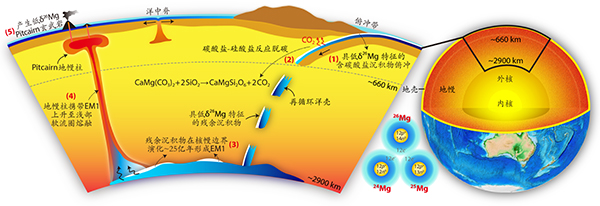With the support of National Natural Science Foundation of China (Project Approval Number: 41372064, 41688103, 41672049), an international research team led by Prof. Chen Lihui (School of Earth Sciences and Engineering, Nanjing University), has made important progress in the field of mantle geochemistry. They found the chemical "imprint" of ancient surficial carbonate in a mantle plume that stems from the Earth's core-mantle boundary. The relevant research results were published in PNAS (Proceedings of the National Academy of Sciences of the United States of America) on August 28, 2018, entitled "Recycled ancient ghost carbonate in the Pitcairn mantle plume". The website link is: http://www.pnas.org/content/115/35/8682.
Understanding the chemical composition and evolution of the mantle, together with the material cycling between the Earth’s deep mantle and its surface, are exceptionally important for us to answer the question of “how does Earth’s interior work?”.Previous radiogenic isotope studies of ocean island basalts (OIBs) have revealed that the Earth’s mantle is highly heterogeneous in chemical composition, and defined several mantle end-members such as EM1, EM2 and HIMU. Although it is believed that the formation of these mantle components is related to the recycling of Earth’s shallow materials, there is still a great controversy as to which kind of recycled materials these mantle components represent. In particular, the fight over the origin of EM1 is the longest-running and most heated debate. EM1 is thus considered to be the most "enigmatic" mantle component.
In order to further explore this puzzle, the research team focused on the most typical EM1-type OIB samples collected from Pitcairn Island (an island produced by partial melting of the Pitcairn mantle plume at about 0.95~0.45 million years ago, Fig.1). They conducted high-precision analysis of Mg, Sr, Nd, Pb, and Hf isotopes, in addition to conventional major and trace elements. Results show that the Mg isotopic compositions of the typical EM1-type OIB samples are significantly lighter than that of the normal mantle. The correlations between Mg stable isotopes and radiogenic isotopes of EM1-type OIBs further suggested that the low δ26Mg values of the EM1-type OIBs are inherited from the EM1 component in the mantle source. The low δ26Mg value of EM1, combined with previously published evidence yielding exceptionally unradiogenic Pb as well as sulfur isotopes affected by mass-independent fractionation, suggests that the Pitcairn EM1 component is most likely derived from late-Archean (2.5~2.6 Ga) subducted carbonate-bearing sediments. This finding clearly indicates that some sediments, which once lay on the Earth’s surface in the Archean, traveled from the Earth’s surface to the core-mantle boundary (~2900 kilometers deep in the Earth) but ultimately came back to the surface to form the volcanic island, after a period of about two and a half billion years staying down below (Fig.2).

Figure 1. Left, the photo of Pitcairn Island. Credit: Takeshi Hanyu/Japan Agency for Marine-Earth Science and Technology. Right, the location of the Pitcairn Island in the South Pacific.

Figure 2. Cartoon showing that some residual components of ancient carbonate-bearing sediments traveled from the Earth’s surface to the core-mantle boundary and ultimately came back to the surface to serve as ingredients of the Pitcairn volcanic island, after a period of ~2.5 billion years staying down below.

Add: 83 Shuangqing Rd., Haidian District, Beijing, China
Postcode: 100085
Tel: 86-10-62327001
Fax: 86-10-62327004
E-mail: bic@donnasnhdiary.org
京ICP备05002826号 文保网安备1101080035号 Copyright 2017 NSFC, All Right Reserved